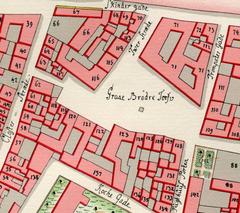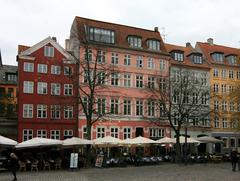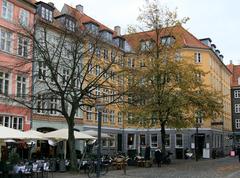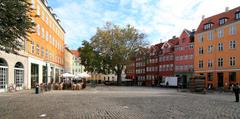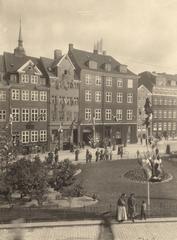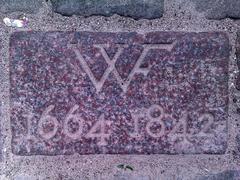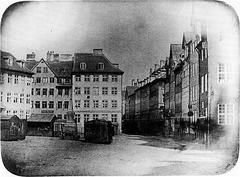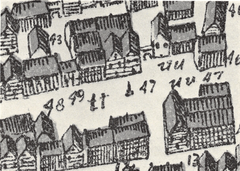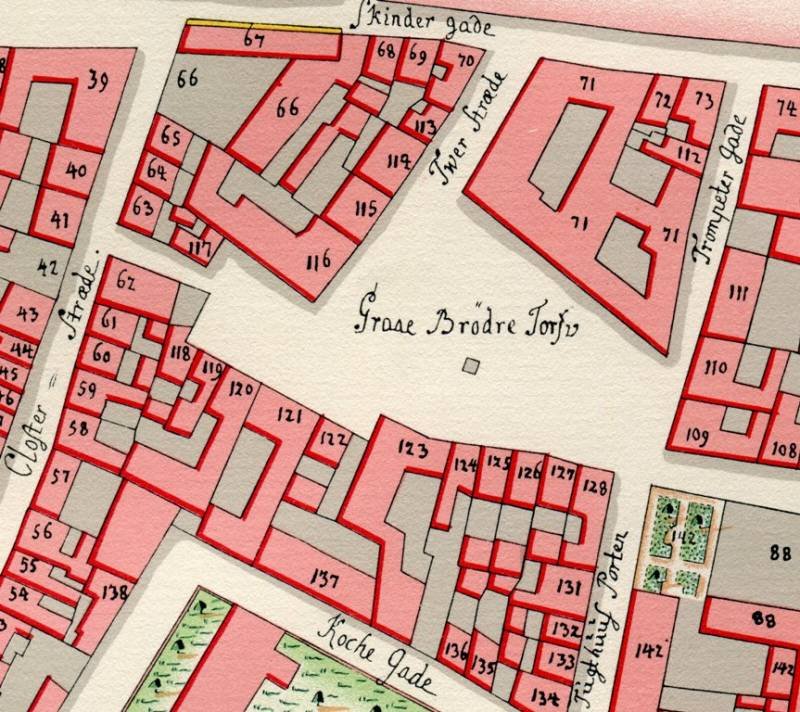
Gråbrødretorv, Copenhagen: Visiting Hours, Tickets & Complete Travel Guide
Date: 03/07/2025
Introduction
Gråbrødretorv—known as “Greyfriars’ Square”—is a historic gem nestled in the heart of Copenhagen’s Old Town. Famed for its colorful facades, lively café culture, and tranquil atmosphere, the square traces its roots back to the 13th century. Today, Gråbrødretorv stands as a vibrant testament to Copenhagen’s resilience and layered history, making it a must-visit for travelers seeking authentic Danish charm and urban vitality (Danish Design Review; travelguide.net).
This guide offers a comprehensive overview of Gråbrødretorv’s history, architectural highlights, visitor information, accessibility, nearby attractions, dining options, and practical tips—ensuring a seamless and enriching visit to one of Copenhagen’s most cherished squares.
Table of Contents
- History and Evolution of Gråbrødretorv
- Architectural Highlights & Urban Layout
- Visiting Information: Hours, Tickets & Accessibility
- Dining and Café Culture
- Events, Activities & Local Life
- Nearby Attractions & Suggested Itineraries
- Practical Tips for Visitors
- Frequently Asked Questions (FAQ)
- Conclusion & Further Resources
History and Evolution of Gråbrødretorv
Medieval Origins
Founded in 1238 as the site of a Franciscan (Greyfriar) monastery, Gråbrødretorv quickly became a spiritual and social center for medieval Copenhagen. The monastery’s dissolution during the Reformation in 1536 marked the square’s first major transformation, as monastic lands shifted to civic use (en.wikipedia.org).
Early Modern Development
By the 16th and 17th centuries, Gråbrødretorv had evolved into a thriving residential and commercial area, its triangular shape defined by medieval streets and its proximity to key landmarks like the Church of the Holy Ghost. Notably, the square has served varied purposes—housing an orphanage, a prison, and even a mansion built by the infamous Corfitz Ulfeldt, whose “pillar of shame” now resides in the Danish National Museum (berloga-workshop.com).
Catastrophe and Renewal
The catastrophic Great Fire of 1728 devastated much of Copenhagen, including Gråbrødretorv. The square was reborn with fire-safety “fire houses” designed by Johan Cornelius Krieger—buildings that still enchant visitors today. The British bombardment of 1807 prompted further reconstruction, layering neoclassical and 19th-century styles atop the original medieval layout (University Post).
20th Century to Present
Efforts in the 20th century transformed Gråbrødretorv into a pedestrian oasis, banning cars in 1968 and fostering a café culture beloved by locals and students. Today, the square’s vibrant energy and historic architecture make it a living symbol of Copenhagen’s adaptability and communal spirit (visitcopenhagen.com).
Architectural Highlights & Urban Layout
Gråbrødretorv is a compact, triangular square covering roughly 3,500 m². Its intimate feel is accentuated by:
- Colorful “Fire Houses”: Post-1728 and post-1807 reconstructions gave rise to the square’s iconic ochre, red, and blue facades, many with steeply pitched roofs and dormer windows (travelguide.net).
- Central Plane Tree: Planted in 1902, this mature tree provides shade and visual unity—a beloved landmark despite its reported decay (guidestory.app).
- Granite Fountain: Designed by Søren Georg Jensen in 1971, the modernist fountain contrasts beautifully with the historic surroundings (berloga-workshop.com).
- Pedestrianization: Since 1968, the square has been car-free, accessible via charming alleys and surrounded by cobblestone paving, which adds to its unique ambiance (danishdesignreview.com).
The result is a harmonious blend of centuries-old architecture and contemporary public space, making Gråbrødretorv an architectural and social highlight of Copenhagen.
Visiting Information: Hours, Tickets & Accessibility
- Hours: Gråbrødretorv is an open public square, accessible 24 hours a day, 7 days a week (visitcopenhagen.com).
- Tickets: There is no entrance fee; the square is free to visit at all times.
- Accessibility: While the square is pedestrian-friendly and mostly level, cobblestones may pose challenges for wheelchair users or those with limited mobility. Surrounding streets offer more accessible entry points (Motion4Rent).
- Getting There: The nearest metro stop is Nørreport (5-minute walk), which is fully accessible. Copenhagen’s extensive bus and cycling infrastructure makes the square easy to reach (VisitCopenhagen).
- Guided Tours: Many walking tours of Copenhagen’s Old Town include Gråbrødretorv. Booking ahead is recommended, especially in peak season.
Dining and Café Culture
The square is lined with cafés, restaurants, and wine bars, many offering outdoor seating in spring and summer. Highlights include:
- Peder Oxe: Classic Danish fare served in a historic cellar.
- Café Katz & Café Vito: Popular spots for coffee, pastries, and people-watching.
- Variety of Options: Menus range from Danish smørrebrød to international cuisine, with vegetarian and vegan options widely available (MissTourist).
Prices are moderate to high due to the central location. Tipping is not obligatory, but rounding up is appreciated.
Events, Activities & Local Life
Gråbrødretorv is a hub for cultural events and local gatherings:
- Copenhagen Jazz Festival: Each July, the square transforms into an open-air stage, attracting music lovers from across the city (berloga-workshop.com).
- Christmas Market: In December, Gråbrødretorv is adorned with festive lights and market stalls.
- Al Fresco Dining & Socializing: The square is renowned for its outdoor café culture, especially in warmer months.
- Photo Opportunities: The colorful facades and lively street scenes are perfect for photography, especially during golden hour (Explore Mindfully).
Nearby Attractions & Suggested Itineraries
Gråbrødretorv’s central location makes it the perfect starting point for exploring Copenhagen’s historic core. Notable nearby attractions include:
- Strøget: One of Europe’s longest pedestrian shopping streets (Authentic Scandinavia).
- The Round Tower (Rundetårn): 17th-century observatory with panoramic city views (ThereSheGoesAgain).
- Kultorvet Square: Another vibrant, café-lined public space.
- Rosenborg Castle & The Botanical Garden: Both a short walk away for those interested in Danish royal history and natural beauty.
Suggested Itinerary: Enjoy morning coffee at Gråbrødretorv, browse shops along Strøget, climb the Round Tower, sample street food at Torvehallerne Market, and end with a canal tour from Nyhavn (WhereGoesRose).
Practical Tips for Visitors
- Currency: Danish krone (DKK). Credit/debit cards are widely accepted.
- Language: Danish is official, but English is spoken everywhere.
- Wi-Fi: Available at most cafés and restaurants.
- Restrooms: Public facilities are nearby; some cafés limit restroom use to patrons.
- Weather: Pack for changeable weather; layers and a rain jacket are recommended.
- Cycling: Copenhagen is bike-friendly with rentals available citywide (Time Out).
- Safety: The area is very safe; standard precautions apply (TravellersWorldwide).
- Etiquette: Danes value politeness and personal space; wait for table service, and greet staff on arrival.
Frequently Asked Questions (FAQ)
Q: What are Gråbrødretorv’s visiting hours?
A: The square is open 24/7, year-round, with free access.
Q: Is there an entrance fee?
A: No, the square is a public space and free to visit.
Q: Are guided tours available?
A: Yes, many walking tours include Gråbrødretorv. Check with local operators.
Q: Is Gråbrødretorv accessible for people with disabilities?
A: The cobblestone surface may be uneven, but the area is mostly level. Nearby transit and some cafés are accessible (Motion4Rent).
Q: What are the best times to visit?
A: Spring to early autumn for lively café life and events; December for festive markets.
Q: What are nearby attractions?
A: Strøget, The Round Tower, Rosenborg Castle, the Botanical Garden, and Kultorvet Square.
Conclusion
Gråbrødretorv is a captivating blend of history, culture, and local life, offering visitors a welcoming oasis in Copenhagen’s bustling city center. Whether enjoying coffee at a sidewalk café, attending a jazz concert, or exploring nearby landmarks, the square invites you to experience the spirit and resilience of the Danish capital firsthand.
Plan your visit today: Download the Audiala app for guided tours, insider tips, and the latest Copenhagen event updates. For more inspiration, explore our related articles and follow us on social media.
References & Further Reading
- Danish Design Review
- University Post
- TravelGuide.net
- VisitCopenhagen
- Lonely Planet
- Berloga Workshop
- Explore Mindfully
- WhereGoesRose
- en.wikipedia.org
- MissTourist
- Authentic Scandinavia
- ThereSheGoesAgain
- Motion4Rent
- Time Out
- TravellersWorldwide
